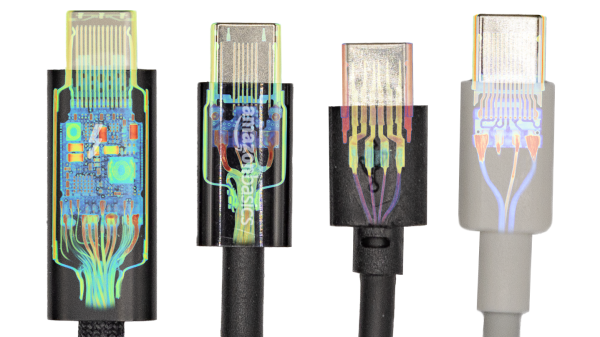What in the world could possibly justify charging $129 for a USB cable? And is such a cable any better than a $10 Amazon Basics cable?
To answer that question, [Jon Bruner] fired up an industrial CT scanner to look inside various cables (Nitter), with interesting results. It perhaps comes as little surprise that the premium cable is an Apple Thunderbolt 4 Pro USB-C cable, which sports 40 Gb/s transfer rates and can deliver 100 Watts of power to a device. And it turns out there’s a lot going on with this cable from an engineering and industrial design perspective. The connector shell has a very compact and extremely complex PCB assembly inside it, with a ton of SMD components and at least one BGA chip. The PCB itself is a marvel, with nine layers, a maze of blind and buried vias, and wiggle traces to balance propagation delays. The cable itself contains 20 wires, ten of which are shielded coax, and everything is firmly anchored to a stainless steel shell inside the plastic connector body.
By way of comparison, [Jon] also looked under the hood at more affordable alternatives. None were close to the same level of engineering as the Apple cable, ranging as they did from a tenth to a mere 1/32nd of the price. While none of the cables contained such a complex PCB, the Amazon Basics cable seemed the best of the bunch, with twelve wires, decent shielding, and a sturdy crimped strain relief. The other cables — well, when you’re buying a $3 cable, you get what you pay for. But does that make the Apple cable worth the expense? That’s for the buyer to decide, but at least now we know there’s something in there aside from Apple’s marketing hype.
We’ve seen these industrial CT scanners used by none other than [Ken Shirriff] and [Curious Marc] to reverse engineer Apollo-era artifacts. If you want a closer look at the instrument itself, check out the video below
Continue reading “Using Industrial CT To Examine A $129 USB Cable”












